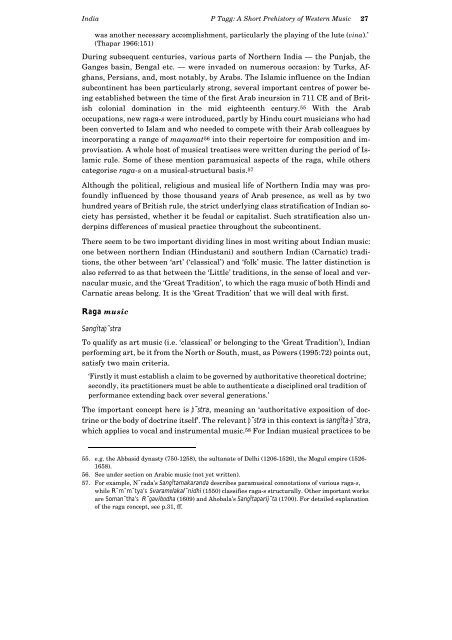A Short Prehistory of Western Music, Chapter 3
A Short Prehistory of Western Music, Chapter 3
A Short Prehistory of Western Music, Chapter 3
You also want an ePaper? Increase the reach of your titles
YUMPU automatically turns print PDFs into web optimized ePapers that Google loves.
India P Tagg: A <strong>Short</strong> <strong>Prehistory</strong> <strong>of</strong> <strong>Western</strong> <strong>Music</strong> 27<br />
was another necessary accomplishment, particularly the playing <strong>of</strong> the lute (vina).’<br />
(Thapar 1966:151)<br />
During subsequent centuries, various parts <strong>of</strong> Northern India — the Punjab, the<br />
Ganges basin, Bengal etc. — were invaded on numerous occasion: by Turks, Afghans,<br />
Persians, and, most notably, by Arabs. The Islamic influence on the Indian<br />
subcontinent has been particularly strong, several important centres <strong>of</strong> power being<br />
established between the time <strong>of</strong> the first Arab incursion in 711 CE and <strong>of</strong> British<br />
colonial domination in the mid eighteenth century. 55 With the Arab<br />
occupations, new raga-s were introduced, partly by Hindu court musicians who had<br />
been converted to Islam and who needed to compete with their Arab colleagues by<br />
incorporating a range <strong>of</strong> maqamat 56 into their repertoire for composition and improvisation.<br />
A whole host <strong>of</strong> musical treatises were written during the period <strong>of</strong> Islamic<br />
rule. Some <strong>of</strong> these mention paramusical aspects <strong>of</strong> the raga, while others<br />
categorise raga-s on a musical-structural basis. 57<br />
Although the political, religious and musical life <strong>of</strong> Northern India may was pr<strong>of</strong>oundly<br />
influenced by those thousand years <strong>of</strong> Arab presence, as well as by two<br />
hundred years <strong>of</strong> British rule, the strict underlying class stratification <strong>of</strong> Indian society<br />
has persisted, whether it be feudal or capitalist. Such stratification also underpins<br />
differences <strong>of</strong> musical practice throughout the subcontinent.<br />
There seem to be two important dividing lines in most writing about Indian music:<br />
one between northern Indian (Hindustani) and southern Indian (Carnatic) traditions,<br />
the other between ‘art’ (‘classical’) and ‘folk’ music. The latter distinction is<br />
also referred to as that between the ‘Little’ traditions, in the sense <strong>of</strong> local and vernacular<br />
music, and the ‘Great Tradition’, to which the raga music <strong>of</strong> both Hindi and<br />
Carnatic areas belong. It is the ‘Great Tradition’ that we will deal with first.<br />
Raga music<br />
SangŸtaþ˜stra<br />
To qualify as art music (i.e. ‘classical’ or belonging to the ‘Great Tradition’), Indian<br />
performing art, be it from the North or South, must, as Powers (1995:72) points out,<br />
satisfy two main criteria.<br />
‘Firstly it must establish a claim to be governed by authoritative theoretical doctrine;<br />
secondly, its practitioners must be able to authenticate a disciplined oral tradition <strong>of</strong><br />
performance extending back over several generations.’<br />
The important concept here is þ˜stra, meaning an ‘authoritative exposition <strong>of</strong> doctrine<br />
or the body <strong>of</strong> doctrine itself’. The relevant þ˜stra in this context is sangŸta-þ˜stra,<br />
which applies to vocal and instrumental music. 58 For Indian musical practices to be<br />
55. e.g. the Abbasid dynasty (750-1258), the sultanate <strong>of</strong> Delhi (1206-1526), the Mogul empire (1526-<br />
1658).<br />
56. See under section on Arabic music (not yet written).<br />
57. For example, N˜rada’s SangŸtamakaranda describes paramusical connotations <strong>of</strong> various raga-s,<br />
while R˜m˜m˜tya’s Svaramelakal˜nidhi (1550) classifies raga-s structurally. Other important works<br />
are Soman˜tha’s R˜gavibodha (1609) and Ahobala’s SangŸtaparij˜ta (1700). For detailed explanation<br />
<strong>of</strong> the raga concept, see p.31, ff.














